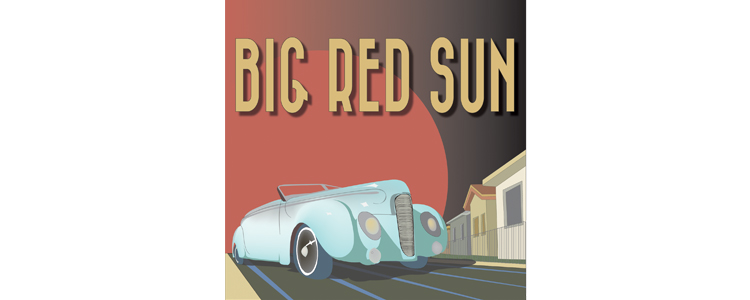Big Red Sun tells the story of a family of musicians. Eddie and Helen Daimler were great swing musicians in the 1940s, but now in the early 1960s their teenage son Harry, a budding songwriter himself, lives alone with his mother and writes songs about his great war-hero father. In an effort to write more truthfully, Harry unearths a dark family secret. World War II carved a silent divide between those who fought and those who waited – a truth unshared. In a few short years, the simple melodies of Kern and Berlin were replaced by the dizzying energy of jazz and the beginnings of rock and roll. This is the story of a family that changed as much as their music did.
There are a few questions that have plagued us since our 2010 appearance at NAMT and our subsequent presentations at CTI and The York, and we’ve rewritten to try to address them. Eddie and Helen are musicians from the 1930s and ’40s and now their son Harry, himself a budding musician, is beginning to embody the sound of the 1960s. Since much of the story is told in flashback, we kept running into the problem that Harry felt like an observer or a narrator, rather than an engine or propeller of the story. By strengthening his relationship to his own music, we’ve got a reason for him to stay on his quest. “How can you have an original voice if you don’t have a story to tell?” is the question Harry keeps asking, and it’s at the center of how the folk music of the 1960s evolved. Harry wants to write music authentically; enough with the false romanticism and lying veneer of the 1950s! He is on the search for “a big story about something true,” and, ultimately, it’s his own story that he finds. We’ve eliminated some of the sub-characters and story lines that were distracting. Aunt Rose is gone, which means we were able to give quite a bit of her material to Eddie and Helen, strengthening their back story and their connection. We’re working to make sure Helen is a full character and not just a reflection of the men around her. We’ve tracked the way the flashbacks get told and we’re actually totally re-writing a few song moments in Act Two. Overall, we’re trying to make sure the show feels both important and entertaining. The songs can do the work of the scenes beautifully, but they also have to be vibrant and alive so you feel them on your skin and not just in your brain.You are preparing for a concert of the show in Philadelphia early next year with 11th Hour Theatre Co. Has preparing for that concert brought about any changes to the script as you now approach it with that process in mind?
We actually have two big events coming up. On January 19th in NYC we are going to present a concert version of the score at 54 Below as part of a new series Jennifer Tepper has created called, “New Musicals at 54: A Showcase Of Our Own.” [note: Tickets for this concert series will go on sale in the coming weeks. We will include more information about this in upcoming newsletters.] About a month later (Feb 27-29) we’ll present the score AND book in a concert reading at 11th Hour Theatre Company in Philadelphia. The relationship with 11th Hour is actually even more extensive than that. We are aiming to do a table read in December and a concert presentation in February with an aim towards a production the following season. All in all we’re doing a year of guided development with Michael O’Brien’s young and exciting company, and that has forced us to get our big ideas solidly onto the page and into the sheet music. Georgia is also using this process to write orchestrations and, inevitably, we’ll wind up with some new demos, too.
What does Big Red Sun need to aid in its development?
We have always said that there is an entire element of the show that we can’t know until we see it. We’ll have a character in a scene in 1963, and then in one exchange of dialogue he turns around and is in a scene in 1942. We have actors playing characters of multiple ages and multiple ethnicities. We have music that spans a few decades of history and includes klezmer, swing, jazz and early rock and roll. Sometimes all you get is a clarinet turning into a saxophone or a piano turning into a guitar to let you know that the times are changing. We have crafted this script and score on music stands for nearly a decade and we are very much looking forward to putting it on human bodies and watching these characters come to life. We need choreography, we need musical instruments, and mostly, we need audiences.
Why should everyone check out Big Red Sun?
Like Harry, we have tried to write “a big story about something true,” but we’ve done it extremely efficiently using six actors and five musicians. It has taken us a long time to get it right, but we are very excited about the way this show has landed. We definitely think you’ll be entertained as you hear the way American pop music evolved through the middle of the last century, but you’ll also, hopefully, get sucked into a story about how a redemptive love can heal a broken family. We really do think we’ve got a Great American Musical baby here, just waiting to be born.


